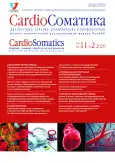Peripheral blood leukocyte telomere length as a possible prognostic marker for the development of atrial fibrillation
- Authors: Nikulina S.Y.1, Shihkova K.Y.1, Shulman V.A.1, Chernova A.A.1, Maksimov V.N.2
-
Affiliations:
- Voino-Yasenetsky Krasnoyarsk State Medical University
- Institute of Internal and Preventive Medicine – a branch of the Federal Research Center Institute of Cytology and Genetics
- Issue: Vol 11, No 2 (2020)
- Pages: 50-54
- Section: Reviews
- URL: https://journals.rcsi.science/2221-7185/article/view/46032
- DOI: https://doi.org/10.26442/22217185.2020.2.200227
- ID: 46032
Cite item
Full Text
Abstract
Atrial fibrillation is one of the most common heart rhythm disorders. The most prominent risk factor for atrial fibrillation is advanced age. Population ageing contributes to an increase in both the prevalence of this pathology and socio-economic burden of the disease for society in general and the patient in particular. Adequate therapy and prevention of atrial fibrillation requires the search for novel prognostic risk markers for disease development, progression, and patients’ response to therapy. One of these markers is the length of telomeres – structures at the ends of chromosomes that protect them from degradation during cell division. The article provides an overview of world studies, both confirming and disproving the role of leukocyte telomere length in atrial fibrillation development.
Full Text
##article.viewOnOriginalSite##About the authors
Svetlana Yu. Nikulina
Voino-Yasenetsky Krasnoyarsk State Medical University
Author for correspondence.
Email: nicoulina@mail.ru
D. Sci. (Med.), Prof., Voino-Yasenetsky Krasnoyarsk State Medical University
Russian Federation, KrasnoyarskKsenya Yu. Shihkova
Voino-Yasenetsky Krasnoyarsk State Medical University
Email: tadtaeva93@mail.ru
Graduate Student, Voino-Yasenetsky Krasnoyarsk State Medical University
Russian Federation, KrasnoyarskVladimir A. Shulman
Voino-Yasenetsky Krasnoyarsk State Medical University
Email: shulman36@mail.ru
Prof., Voino-Yasenetsky Krasnoyarsk State Medical University
Russian Federation, KrasnoyarskAnna A. Chernova
Voino-Yasenetsky Krasnoyarsk State Medical University
Email: anechkachernova@yandex.ru
D. Sci. (Med.), Prof., Voino-Yasenetsky Krasnoyarsk State Medical University
Russian Federation, KrasnoyarskVladimir N. Maksimov
Institute of Internal and Preventive Medicine – a branch of the Federal Research Center Institute of Cytology and Genetics
Email: medik11@mail.ru
D. Sci. (Med.), Prof., Institute of Internal and Preventive Medicine – a branch of the Federal Research Center Institute of Cytology and Genetics
Russian Federation, NovosibirskReferences
- Kirchhof P, Benussi S, Kotecha D et al. 2016 ESC Guidelines for the Management of Atrial Fibrillation Developed in Collaboration With EACTS. Rev Esp Cardiol (Engl Ed) 2017; 70 (1): 50. doi: 10.1016/j.rec.2016.11.033
- Camm A, Kirchhof P, Lip GYH et al. Guidelines for the management of atrial fibrillation. The Task Force for the Management of Atrial Fibrillation of the European Society of Cardiology (ESC). Eur Heart J 2010; 31 (19): 2369–429. doi: 10.1093/eurheartj/ehq278
- Calado R, Young N. Telomeres in disease. F1000 Med Rep 2012; 4: 8. doi: 10.3410/M4-8
- Von Zglinicki T, Martin-Ruiz CM. Telomeres as biomarkers for ageing and age-related diseases. Curr Mol Med 2005; 5 (2): 197–203. doi: 10.2174/1566524053586545
- Benetos A, Kark JD, Susser E et al. Tracking and fixed ranking of leukocyte telomere length across the adult life course. Aging Cell 2013; 12 (4): 615–21. doi: 10.1111/acel.12086
- Bendix L, Thinggaard M, Fenger M et al. Longitudinal changes in leukocyte telomere length and mortality in humans. J Gerontol A Biol Sci Med Sci 2014; 69 (2): 231–9. DOI: 10.1093/ gerona/glt153
- Maximov VN, Malyutina SK, Orlov PS et al. Leukocyte Telomere Length as an Aging Marker and Risk Factor for Human Age-Related Diseases. Adv Gerontol 2017; 7 (2): 101–6. doi: 10.1134/S2079057017020102
- Roberts JD, Dewland TA, Longoria J et al. Telomere length and the risk of atrial fibrillation: insights into the role of biological versus chronological aging. Circ Arrhythm Electrophysiol 2014; 7 (6): 1026–32. doi: 10.1161/CIRCEP.114.001781
- Staerk L, Wang B, Lunetta KL et al. Association Between Leukocyte Telomere Length and the Risk of Incident Atrial Fibrillation: The Framingham Heart Study. J Am Heart Assoc 2017; 6 (11): e006541. doi: 10.1161/JAHA.117.006541
- Siland JE, Geelhoed B, van Gelder IC et al. Telomere length and incident atrial fibrillation – data of the PREVEND cohort. PLoS One 2017; 12 (2): e0171545. doi: 10.1371/journal.pone. 0171545
- Carlquist JF, Knight S, Cawthon RM et al. Shortened telomere length is associated with paroxysmal atrial fibrillation among cardiovascular patients enrolled in the Intermountain Heart Collaborative Study. Heart Rhythm 2016; 13 (1): 21–7. doi: 10.1016/j.hrthm.2015.07.032
- Correction in the Article by Kirchhof et al. «2016 ESC Guidelines for the Management of Atrial Fibrillation Developed in Collaboration With EACTS». Rev Esp Cardiol 2017; 70: 50.e1–e84. Rev Esp Cardiol (Engl Ed) 2017; 70 (11): 1031. doi: 10.1016/j.rec.2017.07.009
- Zhang N, Fan C, Gong M et al. Leucocyte telomere length and paroxysmal atrial fibrillation: A prospective cohort study and systematic review with meta-analysis. J Clin Lab Anal 2018; 32 (9): e22599. doi: 10.1002/jcla.22599
- Kaufman ES. Recurrent atrial fibrillation after ablation: Can telomere length identify patients who are young at heart? J Cardiovasc Electrophysiol 2019; 30 (7): 1125–6. doi: 10.1111/jce.13960
- Su C, Liu Z, Gao Y et al. Study on the relationship between telomere length changes and recurrence of atrial fibrillation after radiofrequency catheter ablation. J Cardiovasc Electrophysiol 2019; 30 (7): 1117–24. doi: 10.1111/jce.13958
- Pan KL, Hsiao YW, Lin YJ et al. Shorter Leukocyte Telomere Length Is Associated With Atrial Remodeling and Predicts Recurrence in Younger Patients With Paroxysmal Atrial Fibrillation After Radiofrequency Ablation. Circ J 2019; 83 (7): 1449–55. doi: 10.1253/circj.CJ-18-0880
- Allende M, Molina E, Gonzalez-Porras JR et al. Short Leukocyte Telomere Length Is Associated With Cardioembolic Stroke Risk in Patients With Atrial Fibrillation. Stroke 2016; 47 (3): 863–5. doi: 10.1161/STROKEAHA.115.011837
Supplementary files







